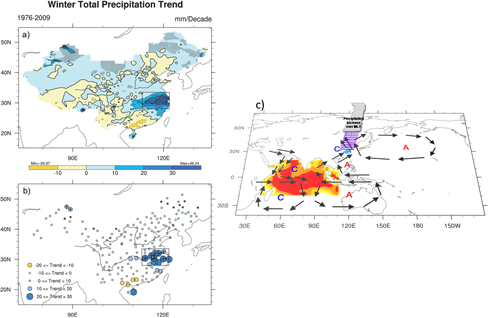Tropical Indian Ocean Warming Intensifies Winter Precipitation over Middle–lower Yangtze River Valley
Date:2015-05-05
The middle–lower Yangtze River Valley (MLYV), located in the middle part of eastern China, is one of China’s largest economic centers, and it has been known as ‘‘the land of fish and rice’’ since ancient times. The MLYV has been impacted heavily by the global climate change. For example, the summer rainfall pattern in China has changed significantly after the abruptly shifting of the global climate system into a new regime in the late 1970s. The prominent change in the summer over China, or the so-called "flood in the south and drought in the north” pattern, features increasing summer rainfall over southern China but decreasing summer rainfall over northern China since the late 1970s. However, the trending variability of winter precipitation over China is still unknown.

Snow scene of Nanjing Yangtze River Bridge (photo from http://news.hexun.com)
Dr. LI Xiao-Feng from the Institute of Atmospheric Physics (IAP/CAS), Prof. LI Jianping from Beijing Normal University (BNU) and Dr. Yun LI from the Commonwealth Scientific and Industrial Research Organization (CSIRO), Australia, investigated the trending variability of the precipitation in winter of China, and reported a significant wetting trend over the MLYV during the three decades since the late 1970s, forming a ‘‘mid-east-China winter wetting’’ pattern. Because no significant trends were observed over the MLYV during the second half of 20th Century, this ‘‘mid-east-China winter wetting’’ pattern after the late 1970s becomes a new rainfall pattern in winter of China. And their further study revealed that the increasing sea surface temperature in the tropical Indian Ocean has made a dominant contribution to the recent winter precipitation increase over the MLYV. Because the tropical Indian Ocean warming has been partly attributed to the increasing green house gas forcing,the ‘‘mid-east-China winter wetting’’ pattern is actually a regional response to the global warming.

Spatial pattern of winter (DJF) total precipitation trend (mm decade-1) over the 34 yearr from 1976 to 2009 based on (a) the NMIC/CMA gridded rainfall data and (b) station rainfall data. C) is the schematic representation of the tropical Indian Ocean warming driving the winter precipitation increase in MLYV.
As most winter precipitation falls in southern China and the MLYV is located on the northern edge of southern China, the fact that the significant wetting trend occurs over the MLY but not in other subregions of southern China suggests the significant northward extension of the precipitation belts in southern China in recent decades.
This finding coincides with the poleward expansion of the Hadley circulation under global warming, and is also a new proof or feature of the weakening of East Asia Winter Monsoon.
The paper has recently been published in Journal of Climate in 2015.
Citation: Li, X.-F., J. Li, and Y. Li, 2015: Recent Winter Precipitation Increase in middle–lower Yangtze River Valley since the late 1970s: A response to warming in tropical Indian Ocean. J. Climate, 28, 3857–3879.
Download: http://journals.ametsoc.org/doi/abs/10.1175/JCLI-D-14-00701.1
Contact: LI Xiao-Feng, lixiaofeng@mail.iap.ac.cn
